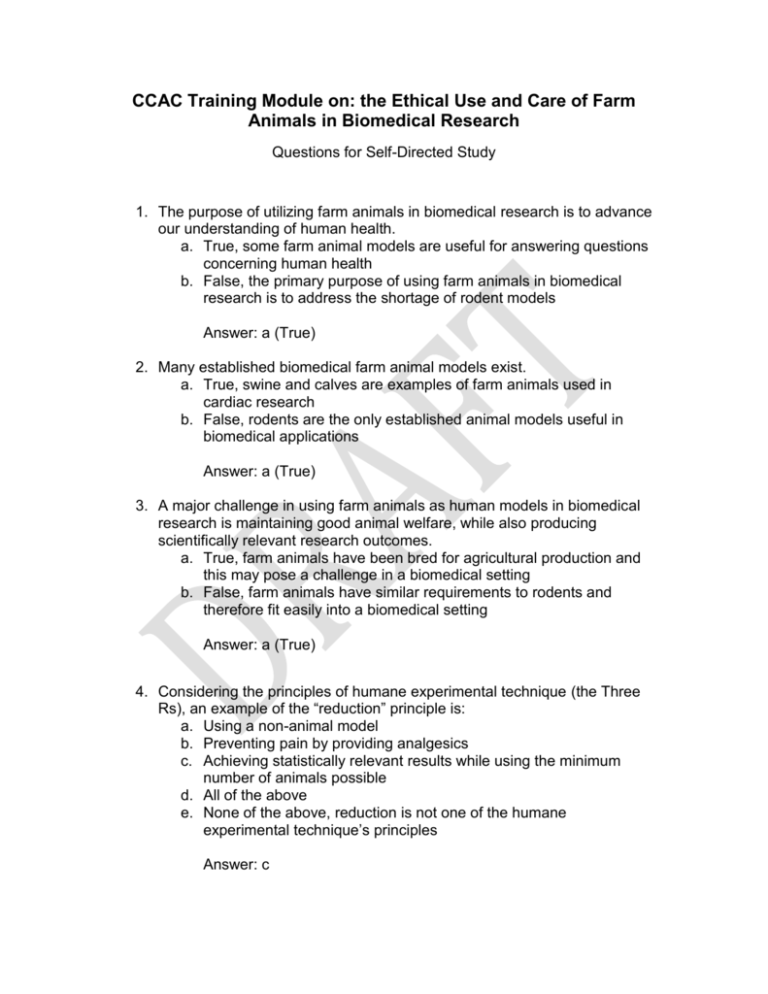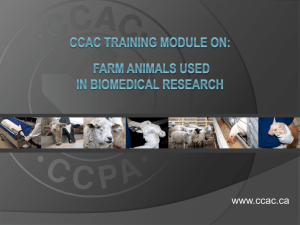Questions
advertisement

CCAC Training Module on: the Ethical Use and Care of Farm Animals in Biomedical Research Questions for Self-Directed Study 1. The purpose of utilizing farm animals in biomedical research is to advance our understanding of human health. a. True, some farm animal models are useful for answering questions concerning human health b. False, the primary purpose of using farm animals in biomedical research is to address the shortage of rodent models Answer: a (True) 2. Many established biomedical farm animal models exist. a. True, swine and calves are examples of farm animals used in cardiac research b. False, rodents are the only established animal models useful in biomedical applications Answer: a (True) 3. A major challenge in using farm animals as human models in biomedical research is maintaining good animal welfare, while also producing scientifically relevant research outcomes. a. True, farm animals have been bred for agricultural production and this may pose a challenge in a biomedical setting b. False, farm animals have similar requirements to rodents and therefore fit easily into a biomedical setting Answer: a (True) 4. Considering the principles of humane experimental technique (the Three Rs), an example of the “reduction” principle is: a. Using a non-animal model b. Preventing pain by providing analgesics c. Achieving statistically relevant results while using the minimum number of animals possible d. All of the above e. None of the above, reduction is not one of the humane experimental technique’s principles Answer: c 5. Which of the following is not a factor necessary for selecting an appropriate farm animal model? a. Lifespan b. Similarity to existing rodent models c. Tolerance to humans d. Husbandry and housing requirements e. Suitability to study objectives and experimental conditions Answer: b 6. Which of the following is most true when farm animals are used in biomedical research? a. When selecting an appropriate animal model consideration should be given for how good animal welfare will be maintained in the proposed experimental conditions b. Some species, such as pigs, have already been established as suitable animal models for many human applications c. Young farm animals are useful in pediatric studies due to the short growth cycle towards adulthood d. All of the above e. None of the above, only rodents should be used in biomedical applications Answer: d 7. Some farm animals commonly used in agricultural production systems may be unsuitable as biomedical models because they: a. Cannot be accustomed to routine handling b. Are too genetically similar to one another c. Are only available to research institutions in rural areas d. Have high growth rates, thereby becoming too large to quickly to be suitable physiological models e. Cannot be held in confined housing for longer than one day at a time Answer: d 8. Farm animals do not make appropriate pediatric models because their time course to adulthood is too accelerated compared to humans: a. True, due to the large amount of human development during the early years, animal models which better match the time course to adulthood (e.g., chimpanzees) should be utilized b. False, the shortened time course to adulthood allows for questions to be addressed in a timeframe better suited to typical research designs Answer: b (False) 9. Farm animals often make better animal models than the traditionally utilized rodent because of their superior genetic variability: a. True, genetic variability is essential in biomedical studies in order to be representative of human genetic variability b. False, genetic variability may create challenges that would not be found in rodents with carefully controlled genetics Answer: b (False) 10. Farm animals housed in long-term biomedical confinement are likely to experience poor animal welfare which may subsequently impact the research outcomes: a. True, animal welfare is negatively impacted by long-term confinement and this can impact research outcomes b. False, animal welfare is negatively impacted by long-term confinement, but because biomedical studies are so closely controlled, research outcomes are not impacted Answer: a (True) 11. When intended research outcomes dictate strict confinement, farm animals need exercise at a minimum of every: a. Two days b. Three days c. Seven days d. Ten days e. Rodents should be used as the animal model, as farm animals cannot be held in strict confinement for longer than one day Answer: c 12. When testing medical devices, farm animal welfare will be impacted most by the: a. Type of device b. Way the device is deployed in the farm animal c. Way the device is controlled and monitored d. All of the above, these factors have an additive effect on farm animal welfare e. None of the above, medical devices only impact farm animal welfare when they fail Answer: d 13. Communicating with an implanted biomedical device can have as much of a negative animal welfare impact as the act of deploying the device within the animal. a. True, the interface required to communicate with a device may be highly intrusive b. False, animal welfare is most impacted during the placement and testing phase of biomedical devices Answer: a (True) 14. In regards to medical devices, protocols should address: a. Performance reliability of device being used b. Biocompatibility between the device and the animal model c. Potential impacts to human handlers due to device failure d. All of the above should be addressed within the protocol e. None of the above, protocols should focus primarily on the protocol procedures required for repairing failed devices Answer: d 15. In order to test device suitability for the target species, it is appropriate to use a non-survival, anesthetized, pain-medicated animal model during the final design refinement stages of a medical device: a. True, using a few non-survival animals for final testing prevents potential animal welfare issues for a larger group of animals if the device needs refinement b. False, using non-survival animals will not identify the potential implications of failure in a live animal and is therefore not recommended Answer: a 16. When a medical device fails and its repair involves major surgery, a farm animal should be euthanized: a. True, in most situations only repairs requiring minor invasiveness should be attempted, otherwise euthanasia may be the most humane option b. False, as long as post-operative pain mitigation is considered, major surgery to complete repairs to devices is acceptable Answer: a (True)





